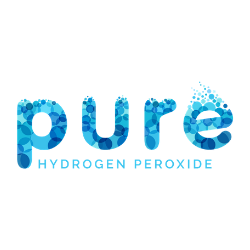What is hydrogen peroxide?
Hydrogen peroxide is a chemical compound composed of water and oxygen. Small amounts of gaseous hydrogen peroxide occur naturally in the air.
Hydrogen peroxide’s chemical formula is H2O2. For reference, water’s chemical formula is H2O. It was first recognized as a chemical compound in 1818, and in 1894, Richard Wolffenstein finally discovered how to produce pure hydrogen peroxide, making it widely commercially available for the first time.
Hydrogen peroxide can be used in multiple settings to kill 99.9% of all microorganisms. It is sporicidal, fungicidal, virucidal, mycobactericidal, and bactericidal that has been proven to even kill the coronavirus (COVID-19). It can be used as a low-level and also high-level disinfectant and as a sterilizer for homes, personal property, and commercial settings such as schools, and in-hospital rooms and equipment depending on its concentration.
More importantly, it is mostly safe and environmentally friendly for humans and pets.
The extra oxygen in hydrogen peroxide attacks and destroys a microorganism membrane lipids, DNA, and other cell components that often function as a defense mechanism. Because of this ability to attack microorganisms’ defenses and relative safety for people, pets, and the environment, it is an excellent antimicrobial disinfectant cleaner and sanitizer.
The CDC report on chemical disinfectants includes protocols for using hydrogen peroxide as low as .05% for a regular disinfecting cleaner. As a high-level disinfectant, the user must employ 7.5% hydrogen peroxide for 30 minutes at 20 degrees Centigrade. To be used as a high-grade sterilizer, the user must use the same concentration for 6 hours at 20 degrees centigrade. It can be used for 21 days and has a stable shelf life of 2 years.
In its purest form, H2O2 is a pale blue liquid that’s more viscous than water and has a bitter taste. It was long believed to be an unstable compound, as the first attempts to separate pure H2O2 from water were unsuccessful. However, the instability was due to trace amounts of impurities, mainly transition-metal salts, that accelerated the decomposition of H2O2.
Hydrogen peroxide quickly decomposes into water and oxygen when heated or exposed to salts of metal, such as nickel, iron, manganese, chromium, or copper. Although non-flammable, it can be unstable, decomposing readily to oxygen and water with release of heat and its potent oxidizing properties can cause spontaneous combustion when interacting with organic material.
There are several different strengths of H2O2 sold in drugstores, supermarkets, and on the commercial market. The most common is 3 percent, which is safe, and hair bleach is about 6%, 8% to 10% hydrogen peroxide. In higher concentrations, it can be used as a bleach for textiles and paper, as a component of rocket fuels, and for producing foam rubber and organic chemicals. Much higher concentrations can be found commercially available from 35% to as high as 50% and 90%. The higher the strength, the more volatile the liquid, and the more bleaching and burning effect it will have to make it dangerous on the eyes and skin of its users.
Hydrogen peroxide is an inexpensive, effective disinfectant and sanitizing agent that has relatively few disadvantages. Of the different disinfectants and cleaners commercially available, time and time again, hydrogen peroxide is far superior at disinfecting and sterilizing an environment.
